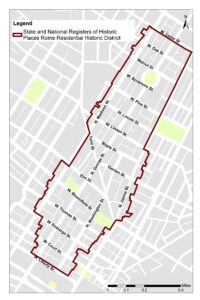The City of Rome has several historically important properties now listed in the New York State and National Listing on the Register of Historic Places, known as the Rome Residential Historic District. The listing provides additional funding resources to protect and enhance the local Historic and Scenic Preservation District and surrounding historic homes not included in the local district, as well as provide further financial resources for capital improvements for building-owners within the boundary.
What are the State and National Registers of Historic Places?
The State and National Registers are the official lists of properties significant in history, architecture, engineering, landscape design, archeology, and culture. Properties may be significant in local, state and/or national contexts. More than 120,000 properties in New York have received this prestigious recognition.
About the new Rome Residential Historic District
The district is roughly bound by West Cedar Street to the North, North James Street to the east, West Liberty Street to the south, and North Madison Street to the west, with the east and west boundaries drawn to exclude areas characterized by significant loss of integrity and/or widespread commercial use conversion, and to exclude the Gansevoort-Bellamy Historic District.
Included in the 952 parcel- district are 839 contributing primary buildings that are mostly single and multi-family residential buildings, with several complimentary religious buildings. The architecture reflects vernacular to high-style interpretations of many nineteenth and twentieth century styles including Federal, Greek Revival, Gothic Revival, Italianate, Second Empire, Stick, Queen Anne, Romanesque, Colonial Revival, Tudor Revival, Mission and Spanish Revival, Craftsman, Ranch, and Split-Level.
For more information about the historic characteristics of the district, you can review the complete nomination: Rome Residential Historic District Final Nomination
Rome Residential Historic District Map
Rome Residential Historic District Address List
How Property Owners in the New District Can Benefit
If you are the owner of a house within the Rome Residential Historic District, you may be eligible for a state historic tax credit equal to 20% of the repair costs through the New York State Historic Homeownership Rehabilitation Credit Program. All of the work must be approved by the Division for Historic Preservation (DHP) before you begin.
Incentives for commercial properties within the new district are available as well. Owners of historic income-producing properties may be eligible for federal and state income tax credits equaling 20%-50% of qualified rehabilitation costs.
Properties within the new district are not subject to any new regulations.
To speak with someone to see if your property and project are eligible to take advantage of these programs, please reach out to:
Christina M Vágvölgyi, Senior Historic Site Restoration Coordinator
New York State Parks, Recreation and Historic Preservation
Phone: 518-268-2217
Email: christina.vagvolgyi@parks.ny.gov
RESOURCES
Homeowner Tax Credit Handout
Homeownership Tax Credit FAQs
NYS Commercial Tax Credit Programs
State Historic Preservation Office State and National Register: https://parks.ny.gov/shpo/national-register/
State Historic Preservation Office Tax Credit Programs: https://parks.ny.gov/shpo/tax-credit-programs/

